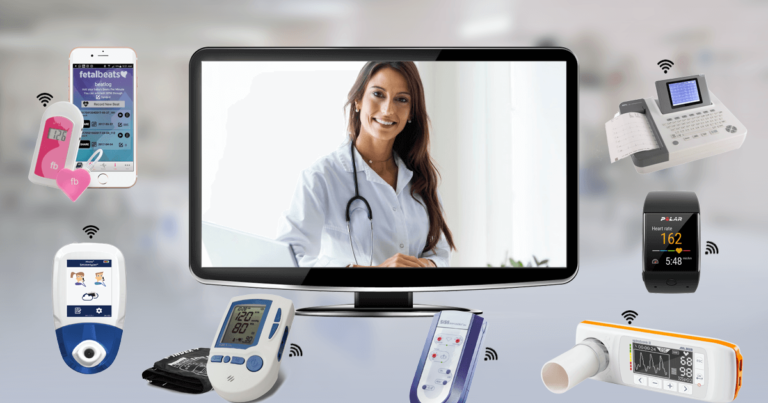Introduction
In recent years, digital healthcare solutions have revolutionized the way healthcare is delivered, particularly in the realm of remote patient monitoring (RPM). By leveraging technology to monitor patients' health status from a distance, RPM offers numerous benefits for both patients and healthcare providers. In this article, we'll explore the features, advantages, disadvantages, possible improvements, and conclusion of digital healthcare solutions for remote patient monitoring.
Features of Digital Healthcare Solutions for Remote Patient Monitoring:
Real-Time Monitoring: Digital healthcare solutions enable healthcare providers to monitor patients' vital signs, symptoms, and health data in real-time, regardless of their location.
Data Collection and Analysis: These solutions collect and analyze patient data from various sources, including wearable devices, mobile apps, and remote monitoring devices, allowing for comprehensive health assessment and early detection of potential issues.
Alerts and Notifications: Digital healthcare platforms can generate alerts and notifications for healthcare providers in case of abnormal vital signs or health indicators, enabling timely intervention and proactive care management.
Patient Engagement: Remote patient monitoring solutions often include patient-facing interfaces that allow individuals to actively participate in their own care by tracking their health metrics, receiving educational resources, and communicating with their healthcare team.
Integration with Electronic Health Records (EHR): Many digital healthcare platforms integrate with EHR systems, enabling seamless sharing of patient data and facilitating continuity of care across different healthcare settings.
Advantages of Digital Healthcare Solutions for Remote Patient Monitoring:
Improved Access to Care: RPM enables patients to receive high-quality healthcare services regardless of their geographic location, reducing barriers to access and increasing convenience for individuals in remote or underserved areas.
Early Detection and Intervention: By continuously monitoring patients' health status, digital healthcare solutions can detect subtle changes or abnormalities in vital signs and symptoms, allowing for early intervention and proactive management of chronic conditions.
Enhanced Patient Engagement: RPM empowers patients to take an active role in managing their health by providing them with access to personalized health data, educational resources, and communication channels with their healthcare providers.
Cost Savings: Remote patient monitoring can lead to cost savings for healthcare systems by reducing the need for in-person consultations, hospital admissions, and emergency room visits, while also improving overall health outcomes and reducing healthcare utilization.
Efficient Resource Allocation: Digital healthcare solutions optimize resource allocation by prioritizing care for patients who require immediate attention or intervention, while also allowing healthcare providers to allocate resources more efficiently based on patient needs and acuity levels.
Disadvantages of Digital Healthcare Solutions for Remote Patient Monitoring:
Technological Barriers: Access to digital healthcare solutions may be limited for certain populations, particularly elderly or underserved individuals who may lack access to internet-connected devices or digital literacy skills.
Privacy and Security Concerns: Remote patient monitoring involves the collection and transmission of sensitive health data, raising concerns about patient privacy and data security, particularly with regard to data breaches or unauthorized access.
Workflow Integration: Integrating digital healthcare solutions into existing clinical workflows and practices may present challenges for healthcare providers, requiring changes in documentation, communication, and care coordination processes.
Reliability and Accuracy: The reliability and accuracy of remote monitoring devices and technologies may vary, leading to potential discrepancies or inaccuracies in patient data and health metrics.
Regulatory Compliance: Compliance with regulatory requirements, such as HIPAA (Health Insurance Portability and Accountability Act) in the United States, adds complexity to the implementation and use of digital healthcare solutions for remote patient monitoring.
Possible Improvements in Digital Healthcare Solutions for Remote Patient Monitoring:
User-Friendly Interfaces: Designing intuitive and user-friendly interfaces for remote patient monitoring platforms can improve usability and accessibility for both patients and healthcare providers.
Interoperability: Enhancing interoperability between different digital healthcare systems and devices can facilitate seamless data exchange and integration, improving care coordination and continuity.
Enhanced Data Security: Implementing robust encryption protocols, authentication mechanisms, and data access controls can strengthen the security and privacy of patient data in remote monitoring platforms.
Standardization and Regulation: Establishing standardized protocols, guidelines, and regulations for remote patient monitoring technologies can promote consistency, quality, and safety in their use across healthcare settings.
Continuous Innovation: Continued innovation and advancement in digital healthcare technologies, such as artificial intelligence, machine learning, and predictive analytics, can further enhance the capabilities and effectiveness of remote patient monitoring solutions.
Conclusion:
Digital healthcare solutions for remote patient monitoring offer significant potential to transform the delivery of healthcare by improving access, efficiency, and quality of care. While these solutions offer numerous advantages, they also pose challenges related to technology, privacy, regulation, and implementation. By addressing these challenges and embracing continuous innovation, stakeholders in the healthcare ecosystem can unlock the full potential of digital healthcare solutions to empower patients, enhance clinical outcomes, and advance the goal of delivering patient-centered care beyond boundaries.

Upvoted. Thank You for sending some of your rewards to @null. Read my last posts to make sure that BLURT burning is profitable for you. Before using this bot please make sure your account has at least 100 BP. Get more BLURT:
@ mariuszkarowski/how-to-get-automatic-upvote-from-my-accounts@ blurtbooster/blurt-booster-introduction-rules-and-guidelines-1699999662965@ nalexadre/blurt-nexus-creating-an-affiliate-account-1700008765859@ kryptodenno - win BLURT POWER delegationNote: This bot will not vote on AI-generated content